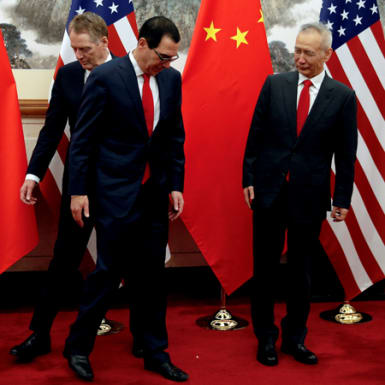global perspectives
US-China trade war: tricky times return


Tricky times have resumed for negotiations on trade between the US and China after US President Trump threatened to increase tariffs on Chinese goods from 10% to 25% from 10 May.
Should tensions escalate significantly in coming days, we expect a pronounced market reaction. There is the potential for a 15%-plus correction in Chinese and emerging market (EM) stocks, and around 5-7% falls in global equities, in our opinion. We are actively monitoring our asset allocation matrix with bullishness tempered to neutral across the risky asset spectrum, and yellow warnings firmly in place.
The good news is that the Chinese delegation, led by Vice Premier Liu He, remains on track to meet US officials this week. Furthermore, comments from US officials suggest that the deal was 90% done before the disagreements took hold.
Still, we highlight that the trade war has been completely priced-out by markets, and caution that the pressure on risky assets led by China-centric assets (equities and bonds) will probably remain for some time. Neither country is likely to complete a U-turn by this Friday’s deadline. We believe a more likely outcome is some sort of delay or postponement, accompanied by a credible and constant threat of potentially increasing tariffs. Should tariffs indeed be raised this week, it is hard to see agreement being reached before a noticeable cooling-off period, even if a deal is struck eventually.
There is considerable potential for economic damage. If tariffs are augmented and their scope expanded to include remaining Chinese imports (around USD300bln), leading to some sort of Chinese response, we estimate Chinese GDP growth in 2019 could suffer by 0.3 to 0.5ppt. This would effectively offset all of stimulus-driven gains accumulated this year.
Volatility on the horizon
We expect volatility to remain elevated amid on-going trade discord. Our views are as follows:
-
Trade negotiations could deteriorate from here before they improve, with a deal potentially being struck in late summer. We expect the tariff increase to be postponed beyond Friday but see tensions remaining high.
-
Volatility is likely to remain elevated generally, and in China-centric assets especially, with news flow driving price swings, we believe.
-
US Treasuries and, to a lesser extent, the dollar, have become a safe haven in the current situation.
-
Positive revisions to global growth are likely to stall as the rebound in Chinese growth is put under the scanner. Already, the positive impact on global growth from China has been softer than expected.
-
If the likelihood continues to rise of tariff implementation, we foresee a period of correction for several weeks, and, in turn, lower rates and central bank dovishness leading investors to search for yield. Even if the threatened tariff increase is postponed, we believe markets will remain jittery – crucially, the foregone conclusion that a trade deal is ‘in the bag’ has been damaged.
We had been turning towards a cautious stance in our asset allocation mix by tempering our bullish views on risky asset to neutral levels, and are now actively building hedges given the scope for sustained volatility in coming weeks.


